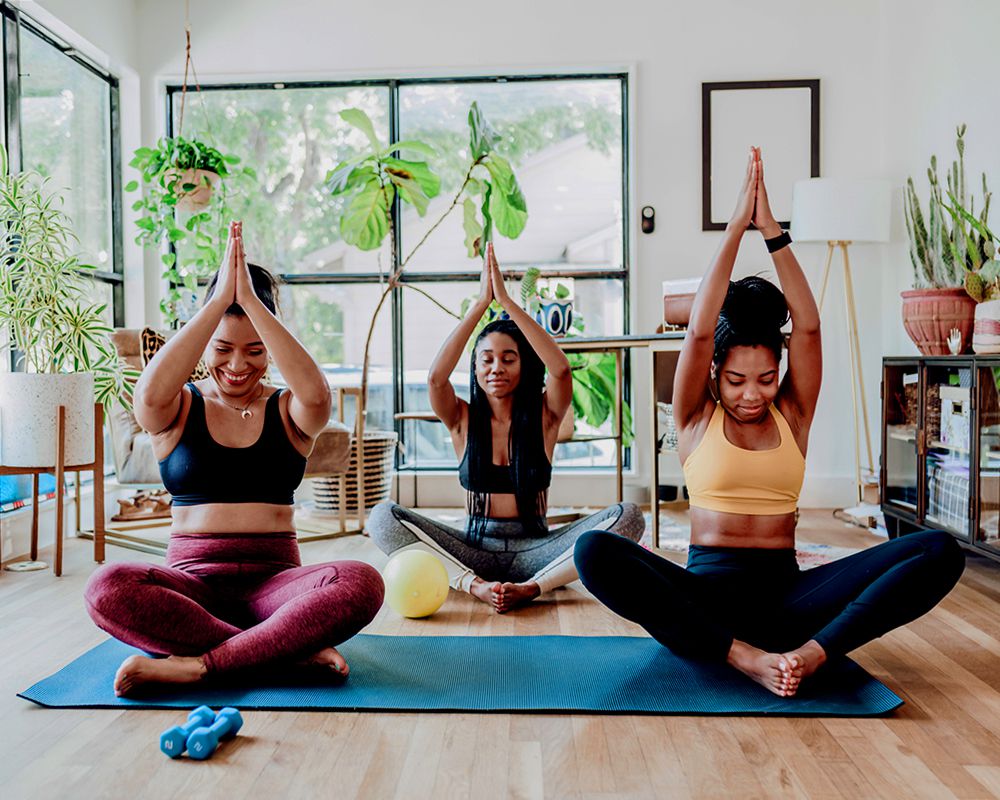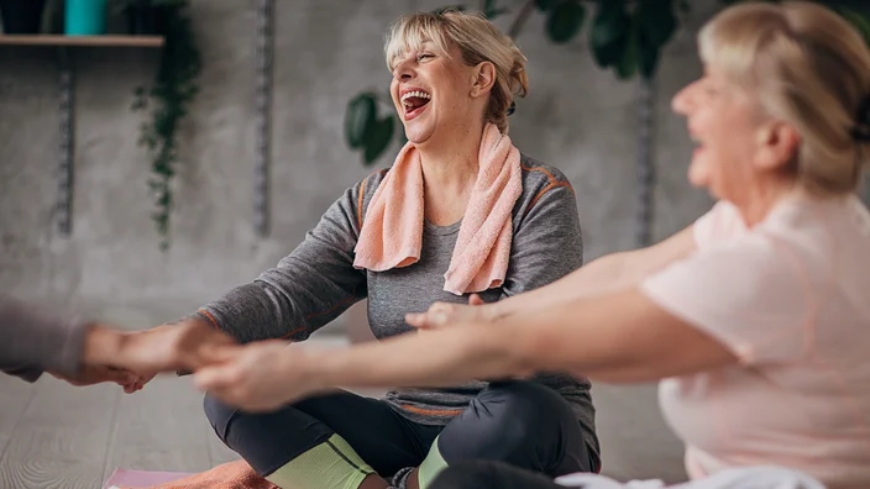Laughing Yoga - How It Redefines Health And Happiness
Laughing yoga works for many individuals as a holistic and enjoyable practice that promotes health and wellness. The intentional cultivation of laughter, coupled with mindful breathing, can contribute to a positive and resilient approach to life.
Author:James PierceReviewer:Karan EmeryOct 02, 202336 Shares36.1K Views

Laughing Yoga, an innovative fusion of intentional laughter and yogic practices, has emerged as a popular and holistic approach to well-being.
This unique form of exercise transcends traditional notions of humor, focusing instead on the therapeutic benefits of laughter for the mind and body.
In this digital age, where stress and sedentary lifestyles often prevail, laughing yoga stands out as a practice that not only promotes physical health but also fosters mental resilience and social connections. From its roots in India to its global reach, laughing yoga has piqued the interest of individuals seeking a joyful and unconventional path to wellness.
Origin Of Laughing Yoga
The concept of laughing yoga was developed by Dr. Madan Kataria, a medical doctor from India, in 1995.
Dr. Kataria was inspired by the idea that laughter, when practiced intentionally, could bring about significant health benefits.
He started the first laughter club in a park in Mumbai with just a handful of participants. Today, laughing yoga has grown into a global phenomenon with thousands of clubs in over 100 countries.
Key Principles Of Laughing Yoga
- Laughter without Reason - One of the central tenets of laughing yoga is the practice of laughter without relying on jokes or humor. Participants engage in spontaneous laughter, often initiated through simple exercises and playful activities.
- Childlike Playfulness - In the spirit of embracing the joyous essence of childhood, laughing yoga encourages participants to let go of inhibitions and be playful. Childlike laughter is not only infectious but also liberating.
- Combining Laughter with Yogic Breathing - Integrating laughter with yogic breathing techniques is a fundamental aspect of laughing yoga. The deep, rhythmic breathing associated with traditional yoga is synchronized with laughter, enhancing its therapeutic effects.
- Eye Contact and Group Dynamics - Laughing yoga is often practiced in groups, fostering a sense of community and shared joy. Maintaining eye contact with fellow participants helps deepen the connection and magnifies the positive impact of laughter.
How Do You Practice Laughing Yoga Exercises?
Practicing laughing yoga exercises involves a combination of intentional laughter, breathing techniques, and playful activities. Here is a step-by-step guide on how to practice laughing yoga exercises:
- Find a Comfortable Space - Start by choosing a quiet and comfortable space where you can move freely without any distractions. This could be indoors or outdoors, depending on your preference.
- Warm-Up - Begin with a gentle warm-up to prepare your body for laughter. You can do some light stretching or simple yoga poses to loosen up your muscles and increase blood flow.
- Clapping and Chanting - The session often starts with rhythmic clapping and chanting. This helps energize the body and creates a positive atmosphere. Clap your hands together while chanting "ho ho ha ha ha" in a repetitive and lively manner.
- Laughter Exercises - Engage in a variety of laughter exercises. These can include:
- Breathing Techniques - Integrate deep breathing exercises into the laughter session. Inhale deeply through your nose, expanding your diaphragm, and exhale slowly through your mouth. This helps in relaxing the body and providing a balance between laughter and controlled breathing.
- Laughter Meditation - Incorporate moments of laughter meditation. Sit comfortably, close your eyes, and focus on the sensations in your body as you recall moments of laughter. This can deepen the meditative aspect of laughter yoga.
- Playful Activities - Include playful activities to stimulate childlike playfulness. This could involve imaginary play, such as pretending to be animals or engaging in humorous role-playing scenarios. The goal is to evoke genuine laughter through lighthearted activities.
- Cool Down - As the session comes to an end, gradually slow down the laughter and engage in some calming exercises. This may include gentle stretches and breathing exercises to bring the body back to a state of relaxation.
- Sharing Laughter - End the session by sharing laughter with others. Stand in a circle, hold hands, and share a moment of collective laughter. This fosters a sense of connection and unity.
- Reflection - Take a few moments for reflection. Notice how your body feels, any changes in your mood, and the overall sense of well-being. This mindfulness aspect is integral to the practice of laughing yoga.
Advanced Applications And Evolving Trends In Laughing Yoga
Laughing yoga, also known as laughter yoga, is an innovative concept that combines laughter exercises with yogic deep-breathing techniques.
The practice aims to promote overall well-being by harnessing the therapeutic benefits of laughter. As we delve into advanced applications and evolving trends in laughing yoga, it becomes evident that this unique form of exercise is not only about amusement but also about enhancing physical, mental, and emotional health.
Advanced Applications
- Corporate Laughter Yoga - In recent years, laughter yoga has found its way into the corporate world. Companies are incorporating laughter sessions as a part of wellness programs for their employees. This is based on the understanding that laughter can reduce stress, improve team dynamics, and enhance creativity. It serves as an unconventional yet effective tool for team building and fostering a positive work environment.
- Laughter Therapy for Health Conditions - Laughing yoga is increasingly being recognized as a complementary therapy for various health conditions. It is used alongside traditional medical treatments to support individuals dealing with chronic illnesses, such as cancer, where laughter is believed to boost the immune system and alleviate pain. Additionally, laughter yoga is explored in mental health settings to assist individuals with anxiety and depression.
- Online Laughing Yoga Classes - The digital era has brought about a shift in how people access fitness and wellness programs. Laughing yoga has adapted to this trend with the emergence of online classes. Participants can join virtual laughter sessions from the comfort of their homes, connecting with laughter enthusiasts worldwide. This flexibility has contributed to the global accessibility and popularity of laughing yoga.
Evolving Trends
- Laughter Meditation - Beyond the physical benefits, there is a growing interest in the meditative aspects of laughter. Practitioners are exploring laughter meditation, where laughter is not just an expression but a mindful practice. This trend involves integrating laughter with mindfulness techniques, emphasizing being fully present in the laughter experience.
- Laughter Yoga Retreats - Laughing yoga retreats have gained traction as individuals seek immersive experiences to deepen their laughter practice. These retreats often take place in serene environments, combining laughter sessions with traditional yoga, meditation, and holistic wellness practices. Participants not only benefit from the laughter exercises but also rejuvenate in tranquil settings.
- Scientific Research and Validation - As laughing yoga gains popularity, there is an increasing focus on scientific research to validate its benefits. Studies exploring the physiological and psychological impacts of laughter yoga are contributing to its acceptance in mainstream healthcare. This trend indicates a shift from anecdotal evidence to empirical support for the efficacy of laughing yoga.
What Are The Benefits Of Laughing Yoga?
Laughing yoga, a unique combination of laughter exercises and yogic principles, offers a myriad of physical, mental, and emotional benefits. Here are some of the key advantages of practicing laughing yoga:
- Stress Reduction - Laughter triggers the release of endorphins, the body's feel-good hormones. This natural chemical response helps reduce stress and promotes a sense of relaxation, contributing to overall well-being.
- Improved Mood - Engaging in laughter yoga regularly can significantly enhance mood and create a positive outlook on life. The act of laughing, even if initiated artificially, has a profound impact on neurotransmitters that influence mood.
- Enhanced Immune Function - Laughter has been associated with improved immune function. The release of neuropeptides and the activation of immune cells during laughter contribute to a stronger immune system, helping the body fight off illnesses.
- Cardiovascular Health - Laughter is known to have cardiovascular benefits. It can increase blood flow, improve circulation, and contribute to the relaxation of blood vessels. These effects may help reduce the risk of heart-related conditions.
- Increased Oxygen Intake - The deep-breathing exercises incorporated into laughing yoga sessions enhance oxygen intake. This improved oxygenation of the body can boost energy levels, increase alertness, and contribute to better overall respiratory health.
- Muscle Relaxation - Laughter involves the contraction and relaxation of various muscles, leading to a state of physical relaxation. Tension in the muscles decreases, providing relief from muscle stiffness and promoting a sense of ease.
- Social Connection - Laughing yoga is often practiced in group settings, fostering social connections and a sense of community. Shared laughter creates bonds between participants, promoting a positive and supportive environment.
- Enhanced Lung Capacity - The deep belly laughter encouraged in laughing yoga sessions improves lung capacity. This can be particularly beneficial for individuals with respiratory conditions and helps in promoting better respiratory health.
- Pain Reduction - Laughter has been shown to increase the body's production of natural painkillers, providing a natural and holistic way to manage pain. It may be particularly helpful for individuals dealing with chronic pain conditions.
- Improved Cognitive Function - Laughter stimulates both the left and right sides of the brain, promoting better cognitive function. It can enhance creativity, problem-solving skills, and overall mental clarity.
- Emotional Resilience - Regular practice of laughing yoga can contribute to emotional resilience. It provides individuals with a coping mechanism for dealing with life's challenges, fostering a more optimistic and resilient mindset.
- Quality of Life - Ultimately, the combination of physical, mental, and social benefits contributes to an overall improvement in the quality of life. Laughing yoga encourages a holistic approach to well-being that goes beyond the physical aspect.
It's important to note that the benefits of laughing yoga are not solely contingent on external sources of humor. The intentional practice of laughter, even without a reason, can bring about these positive effects. Incorporating laughing yoga into one's routine, whether through group sessions or personal practice, can be a joyful and health-enhancing endeavor.
Does Laughing Yoga Work?
You've probably seen that laughing can have an immediate positive impact, like elevating your mood. However, the long-term advantages of routine, daily laughter are receiving more focus.
Endorphins and "happy" hormones like dopamine and serotonin are first released when you laugh. It inhibits stress hormones like cortisol. These outcomes are associated with improved mood, lessened pain, lower blood pressure, a stronger immune system, fewer levels of stress, and lower rates of depression.
Additionally, sharing a laugh with others helps enhance bonds and social connections as well as interpersonal interactions. It's also connected to sentiments of safety and security, which makes one feel more at ease.
According to several researchers, the body cannot tell the difference between forced laughter and true (spontaneous) laughter, thus you can actually gain from it.
Simulated laughter was found to reduce depression rates and elevate mood in a 2019 review. The majority of people can readily participate in laughter exercises because they don't rely on subjective humor and only demand a little amount of intellect.
Other research has demonstrated that laughing yoga can temporarily lower cortisol levels and stress, boost mood and energy, and foster a more optimistic outlook. In fact, it might be just as good at lowering self-reported stress as aerobic exercise.
However, other experts contend that it is challenging to determine the true benefits of laughing yoga for both physical and mental health due to the small sample sizes, subjectivity, and lack of consistency between research. Consequently, more extensive investigation is required.
Laughing yoga should not take the place of any current therapies you are receiving from your healthcare practitioner, despite the fact that it may assist greater mental and physical wellness. Instead, it can be combined with other things.
However, practicing laughing yoga has almost no drawbacks and is accessible to people from all areas of life.
Is It Possible To Practice Laughter Yoga On Your Own?
Yes, you can perform laughter yoga by yourself without joining a group session. There are many tools available to direct your solo practice.
You can start your solo session by performing the following seven steps.
- If you can, take a seat in front of a mirror.
- Make the "ho ho" chant while extending your hands away from your chest.
- Say "ha ha" aloud while lowering your hands to the ground.
- As you keep saying "ho ho" and "ha ha ha," sway from side to side.
- Breathe in deeply and expel completely many times.
- Breathe deeply as you raise your arms above your head.
- As you exhale, repeat "ha ha ha."
You can practice making various laughing noises during your session, such as "ha ha" or "he he." After that, alternate between inhaling deeply and holding it in and exhaling laughing.
You might also attempt to fake a chuckle to see how it feels, but it can seem awkward at first. When practicing alone, it can sometimes be simpler to chuckle softly or giggle. You could also experiment with various body positions. For instance, you may sit and chuckle while holding your knees.
FAQs
Is Laughing Yoga A Solo Or Group Activity?
Laughing yoga can be practiced both individually and in groups. Group sessions, however, are common and contribute to a sense of community, shared laughter, and social connection.
Are There Variations Of Laughing Yoga?
Yes, there are various styles and approaches to laughing yoga. Some incorporate elements of traditional yoga, meditation, or focus on specific themes, such as laughter therapy for health conditions.
Can Laughing Yoga Be Done Online?
Absolutely. With the rise of virtual platforms, laughing yoga classes are often conducted online. This allows participants to join from the comfort of their homes and connect with laughter enthusiasts globally.
How Does Laughing Yoga Work?
Laughing yoga works by incorporating intentional laughter, playful activities, and yogic breathing exercises. The combination of these elements triggers physiological responses, such as the release of endorphins, and contributes to stress reduction and overall health.
How Long Are Typical Laughing Yoga Sessions?
Laughing yoga sessions typically last around 30 to 60 minutes. The duration allows participants to engage in a variety of laughter exercises, breathing techniques, and relaxation activities.
Conclusion
Laughing yoga, with its intentional laughter, deep-breathing techniques, and playful activities, offers a refreshing perspective on health and happiness.
As scientific research continues to explore the physiological and psychological impacts of this practice, the resounding feedback from practitioners supports the idea that laughing yoga does indeed work as a positive and enjoyable tool for enhancing both physical and mental well-being.
Whether practiced individually or in a group, in-person or online, laughing yoga continues to inspire laughter, connection, and a holistic sense of wellness in those who choose to embrace its joyful path.

James Pierce
Author

Karan Emery
Reviewer
Latest Articles
Popular Articles

